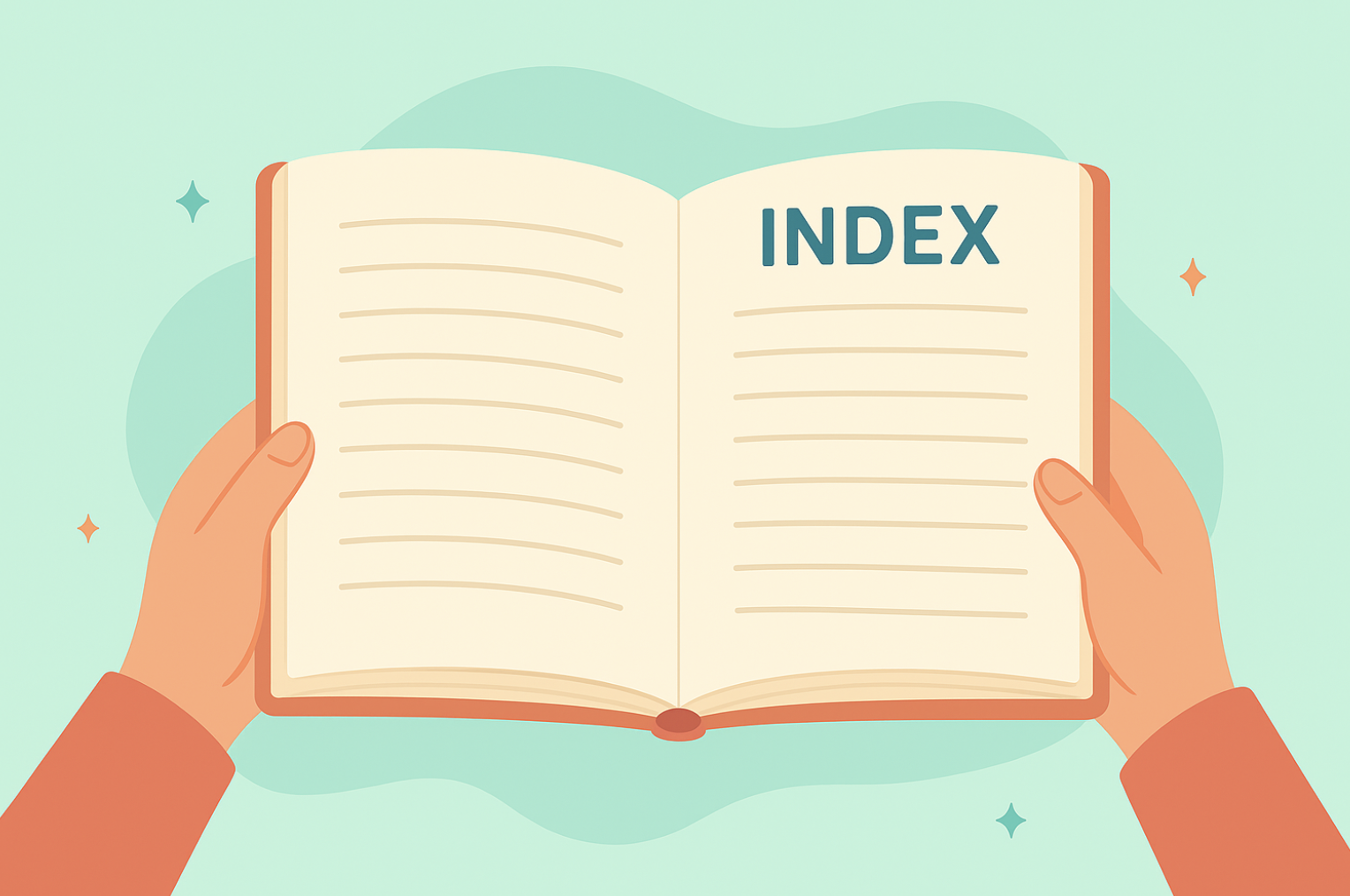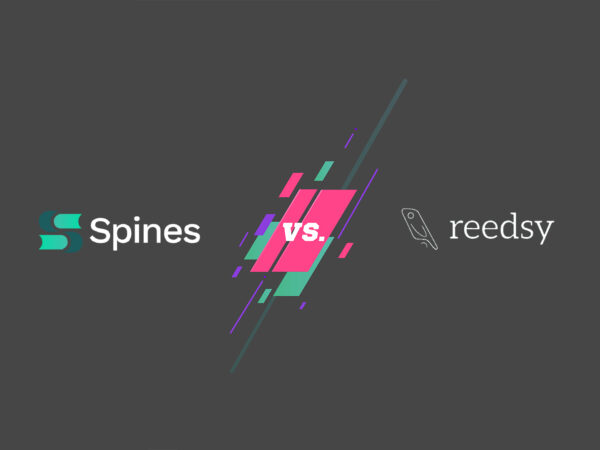Ever caught yourself flipping straight to the back of a book before reading a single page? Don’t worry, you’re not alone—many of us turn directly to the book index page like literary treasure hunters, hunting for that one golden nugget of info we really came for.
But that humble list of topics isn’t just a convenience; it’s the result of centuries of scholarly ingenuity. Indexes date back to the 13th century when monks, probably tired of endlessly scrolling, by candlelight no less, started alphabetizing topics in manuscripts. These early efforts planted the seed for what we now recognize as the modern index: a logical, alphabetical roadmap to everything inside a book, from aardvarks to Zeno’s paradox.
So, what is an index in book terms? It’s not just the fine print at the end. It’s a precision-engineered tool designed to help readers zero in on exactly what they need, without flipping blindly through 300 pages and praying to the gods of pagination.
In the age of infinite scroll, the book index remains a marvel of analog search. And trust us, once you understand its purpose, you’ll never overlook it again.
“Not Just Alphabet Soup” – What Is an Index in a Book?
So, what is an index in book lingo, exactly? Think of it as the GPS of the printed world—a hyper-organized, alphabetical guide that points you straight to the stuff you care about. No fluff, no filler, just pure navigational bliss. While the table of contents is like a map of a city’s neighborhoods, the index of a book is your savvy local tour guide who knows exactly where the best pizza joint—or elusive philosophical concept—is hiding.
Located typically at the end of a non-fiction book, the index is a curated reference list of keywords, names, places, and subjects that appear in the text. Each entry is followed by the page numbers where that topic appears. Sub-entries dive deeper, breaking complex subjects into more specific parts. For example, an entry might look like:
Dragons
— etiquette, 57
— fire-breathing technique, 103–105
— in modern real estate law, 202
The format is clean, alphabetical, and incredibly user-friendly. Whether you’re skimming through Unicorn Law for Beginners (because, of course, that is on your shelf) or doing serious research for a thesis, a well-crafted index saves you from the medieval torture of aimless flipping.
The index of a book isn’t just for scholars or students—it’s for anyone who wants to interact with content in a smarter, faster, less painful way. If books are treasure chests, the index is the secret map. And unlike most modern tech, it never crashes.
Your Publishing Journey Awaits – Start NowShortcut to Sanity – Why Readers (And Writers) Should Love the Index
The index page in a book is the literary equivalent of a GPS system—except it doesn’t yell at you when you miss a turn. It’s there to get you from “Where the heck is that quote?” to “Ah, page 149!” in record time. For readers, it’s a shortcut to sanity: no aimless scanning, no frantic sticky notes, just direct access to the knowledge you need.
Whether you’re diving into a dense biography, flipping through a textbook before finals, or trying to find that one elusive chocolate cake recipe in a 400-page dessert compendium, the index of a book is your best friend. It offers clarity in chaos, a beacon in the informational fog, and, let’s be honest, a little peace of mind when you’re pressed for time (or patience).
But it’s not just readers who should send thank-you notes to the humble index. Writers—especially of nonfiction, cookbooks, and memoirs—use the index as both a roadmap and a mirror. It helps them reflect on the structure of their work: Are topics covered consistently? Are the themes clear? Is the dragon etiquette section, perhaps, overkill?
A solid back-of-the-book reference also boosts credibility. It shows the author respects the reader’s time and intellect. It whispers, “I’ve got you,” while delivering a seamless reading experience.
So next time you crack open a book, give that tidy little subject guide some love. It’s working harder than you think.
Anatomy of the Index
The book index page might look like a dry list, but it’s actually a finely tuned machine of order and efficiency. The index of a book includes three main parts: entries (the main topics), subentries (specific aspects of those topics), and page references (where to find them). It’s like a treasure map—with fewer skulls, more page numbers.
Topics are chosen by indexers (yes, actual people), who sift through the text to pinpoint the ideas, names, and themes readers might search for. Think of it as a subject list that predicts your curiosities before you even know you have them.
To read an index well, scan the entries, dive into subentries, and follow any “see also” clues. Don’t just settle for the first mention—good stuff often hides deeper.
And yes, indexes can be hilarious. Some gems include “Egg, advice on frying an,” from The Joy of Cooking, or “Underwear, causes of loss of,” from a military survival manual.
So, beneath its alphabetized calm, the keyword directory at the back of your book is a sneakily clever tool—equal parts roadmap, rabbit hole, and comedy setlist.
The Art of Organized Obsession
Creating the index of a book isn’t some afterthought slapped on in a rush. It’s a precise, often painstaking craft handled by a rare breed: the professional indexer. These folks are part detective, part editor, and part obsessive-compulsive superhero. Many are freelancers, hired specifically to decode a manuscript and turn its contents into a crystal-clear roadmap.
Indexing is a mix of tools and touch. Yes, there’s software that can help—tagging terms, generating rough lists—but no algorithm can replace the human eye for nuance. Only a person can tell when “bats” refers to flying mammals, baseball gear, or someone’s questionable ex.
Think of indexing as literary cartography: mapping out a book’s ideas the way explorers chart coastlines. Each entry is a landmark, each subentry a footnote in the terrain of the text. The result? A topic mapping system that guides readers across intellectual landscapes.
Technology is streamlining some parts of the job, but the final polish still depends on human judgment, knowing what readers will look for, and how they’ll think. That’s what turns basic content sorting into an art form.
So the next time you consult an index, remember: someone obsessively organized all that chaos just so you could find “dragon fire regulations” in two seconds flat.
Indexing Done Right (and Hilariously Wrong)
The index isn’t always a dry roll call of topics—it can be a playground for creativity, wit, and even mischief. Some authors and indexers use this clever back matter to sneak in jokes, build character, or add an extra layer of delight to the reading experience.
Take Douglas Adams, who famously indexed The Hitchhiker’s Guide to the Galaxy with gems like:
“Universe, the: extant status of, disputed.”
Or Terry Pratchett, who used the index of his Discworld books to continue world-building with entries that were mini-comedies in themselves.
Even cookbooks get in on the fun. The Joy of Cooking has entries like:
“Eggs, how to poach, 103; how not to poach, 104.”
That’s not just helpful—it’s hilarious.
These moments of creative indexing aren’t just clever—they deepen engagement. They tell the reader, “Yes, we know you’re flipping back here. Let’s make it worth your while.” It’s where information meets personality.
A well-crafted index of a book can surprise you, make you laugh, and remind you that every part of a book—even the back—is a chance for storytelling.
Why the Index Deserves Your Attention (and a Standing Ovation)
So, what is an index? It’s clarity, distilled. It’s the backstage pass to knowledge, the unsung hero of organization, and, occasionally, the sneaky comic relief. Far from being an afterthought, the index of a book empowers readers to dive straight into the good stuff, armed with direction, insight, and a few unexpected laughs.
Beyond its function, the book index page is a celebration of structure, intention, and yes, a bit of obsession. It quietly holds a book together long after the last chapter ends.
So next time you find yourself at the back of a book, take a moment. Admire the alphabetized art form. Appreciate the invisible hand that made finding that one weird fact about medieval swordfish possible. There’s hidden beauty in what most readers overlook—and the index is proof.
FAQs – What Is an Index in a Book?
Q: Why is it called an index?
The word index comes from the Latin indicare, meaning “to point out” or “indicate.” That’s exactly what an index does—it points readers to where information lives in a book. It’s like the finger that helps you navigate through a sea of pages, directing you to the right spots quickly and efficiently.
Q: Are glossary and index the same?
Not quite. A glossary defines terms used in the book, like a mini dictionary. An index, on the other hand, tells you where to find those terms (and other topics) throughout the book. Think of the glossary as a list of meanings, and the index as a list of locations.
Q: What are the benefits of an index at the end of a text?
An index boosts usability. It helps readers find specific content fast, improves comprehension by organizing concepts, and even enhances the professional polish of a book. Whether you’re studying, researching, or skimming for fun facts, an index turns the hunt into a hop.
Q: Do you need an index in a book?
If the book is nonfiction, dense, or reference-heavy—yes, absolutely. An index adds major value by making content searchable and accessible. For fiction, it’s not typically needed (unless you’re George R.R. Martin and your readers need a roadmap for all those noble houses).
Q: What goes on an index page?
The index page contains an alphabetized list of key names, topics, terms, and sometimes quirky references found throughout the book. Each entry includes the page number(s) where it appears. Subentries offer more detail, and cross-references may guide readers to related topics.
Q: What is an example of an index?
Here’s a fun fictional example from a book titled Dragons: A Survival Guide:
Dragons
— behavior in captivity, 43–45
— diet preferences, 88–91
— flame types, 12, 33, 102
— treaties with elves, 149
Each line tells you where to find that topic, saving you from flipping through every chapter hoping for a scaly clue.







